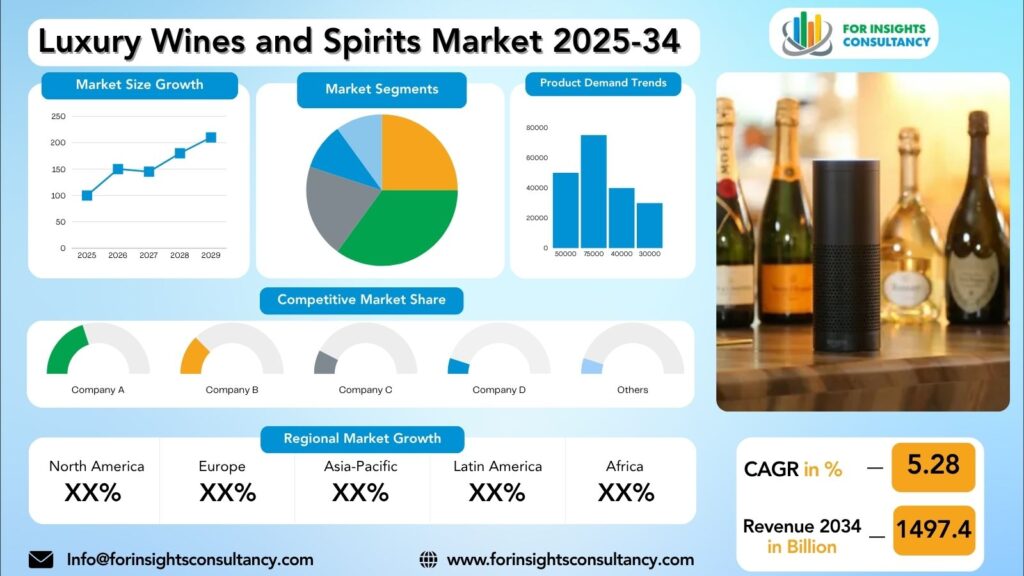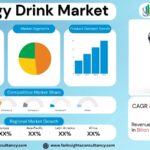
Luxury Wines and Spirits Market Size, Trends Analysis Research Report by Type (Wines/Champagnes, Spirits), by Distribution Channel (Retail (Off-Trade), Wholesale, E-commerce/Online Platforms, On-Trade (e.g., Hotels, Restaurants, Cafeterias, Clubs), Duty-Free/Travel Retail), and By Region Global Market Analysis And Forecast, 2025-2034
Oct-2025 Formats | PDF | Category: Food and Beverages| Delivery: 24 to 72 Hours
Luxury Wines and Spirits Market Is Forecast to Increase from USD 923.7 Billion In 2025 To USD 1497.4 Billion By 2034, At A CAGR Of 5.28%.
Luxury Wines and Spirits Market: A Comprehensive Overview and Future Developments
The market for luxury wines and spirits is presently a lively and energetic sector. It is an exciting evolution, with the dynamics of the market, which are being determined by the changes in consumer preferences, and the growth of global affluence. The luxuries market is worth several hundreds of billions of U.S. dollars and is projected to have a strong growth rate. It is a market that depends on the trend of premiumization, where consumers in developed and rapidly growing emerging economies, such as the Asia-Pacific, are increasingly willing to pay more for quality, exclusive, and authentic products.
The main source of the success of the market for luxury liquors is the consumption phenomenon itself; these luxury drinks are no longer perceived just as personal consumables, but rather as status symbols, integral parts of lifestyle and the market of rare and valuable things. For instance spirits, especially luxury whiskey have been and will continue to be the leading part of the market, nonetheless, luxury wine and champagne have gained enough prestige to hold a significant position as well.
Gazing into the future, a range of exciting occurrences will define the upscale market for wines and spirits. The very first reason is the increase in consumption, which is basically the want of people for product authenticity, guarantee of sustainability, and being put in the know. Meanwhile, companies telling the truth about their past, traditional method of production, good morals in trading etc. will be boosted in their competitiveness. The last digital marketing boom is also key to the transition. E-commerce and direct-to-reach-consumer (D2C) models now constitute part of the channel that opens the door to the privileged products sector, enabling access to a large younger, more digitally engagé clientele (Millennials and Gen Z).
Market Insights
- North America holds the largest share of the global luxury alcohol market, accounting for an estimated 32.7% in 2024.
- One report projects the Asia Pacific region’s luxury alcohol market to reach a CAGR of 5.9% through 2034, driven by rapid urbanization and a growing affluent class.
- The urban population as a percentage of the total population in the United States in 2024 is estimated to be approximately 83.52% (according to World Bank data).
- Luxury Spirits as the largest segment share, with Whiskey and Red Wines driving overall category expansion.
- Vodka dominating the market share in many regions due to its versatility and diversification into flavored and premium varieties.
Market Dynamics
Trends
The luxury wines and spirits market keeps these trendy changing all the time. Their focus is mainly on the evolving consumer preferences and lifestyles. Presently these are some of the trends: a more significant demand for organic and environmentally friendly products, great curiosity for the exclusive and limited editions, and the growing popularity of the crafts and the small-batch distilleries. The luxury consumers are also looking for more experiential purchases as luxury wine tastings, distillery tours, and exclusive events. Moreover, the development of e-commerce has simplified consumer access to a diverse range of luxury wines and spirits from various parts of the world, resulting in a more globalized market. In general, the luxury wines and spirits market is a vibrant one and is still responding to the changing needs of luxury consumers.
Growth Drivers
The Luxury Wines and Spirits Market is growing strongly, and the reasons for this are multiple. Among the main factors leading to this increase is the rising disposable income of consumers, especially in emerging markets, which has resulted in the demand for premium and luxury products to go up. Moreover, the market has been dragged by consumers’ shifting preferences for superior and exclusive beverages. The increasing popularity of gourmet dining and the emergence of a worldwide cocktail culture have also been the positive factors that led to the expansion of the luxury wines and spirits market. Besides this, the role of social media and other digital platforms in advertising luxury brands has been very instrumental in broadening the market and attracting more affluent consumers.
Restraints
Luxury wines and spirits industry is severely limited by the most important of these – strict and tightly controlled regulatory paperwork and high taxes. Wherever you go in the world, local governments are likely to impose very high excise duties and taxes and, as a result, the luxury products end up being very expensive, not accessible to a wide range of consumers. Moreover, the regulatory puzzle that consists of advertising and promotion restrictions, compulsory labeling makes brands, especially smaller ones, pay higher for complying with these regulations. A second heavily impaired factor is the increasing health consciousness trend and the shift towards products with low or zero-alcohol content.
If we take into consideration that consumers, especially the young ones, are more and more health-conscious and are ready to associate less than high levels of alcohol consumption with good health, then the demand for traditional, high-proof luxury drinks is evidently declining. This situation compels established brands to come up with innovations and to retune their assortments. In addition to these, the market is constantly haunted by the issue of counterfeiting and the infringement of intellectual property rights. The trade in fake luxury products is a reason for the loss of the brand’s authentic character, its good name, and may lead to fewer sales of the original products. In order to fight this constant enemy and to keep the consumers’ faith in the quality and rarity of their products, brands are forced to put a big investment in high-tech authentication and supply chain security technologies.
Opportunities
As the Luxury Wines and Spirits market is going to have a bright future with an increasing demand for the product, there are plenty of great possibilities to explore. One of the most important opportunities is to provide products that are rare and exclusive to meet the needs of wealthy buyers. By creating a collection of limited edition and vintage wines and spirits, companies can access this niche market segment and attract customers who want to get new experiences.
Besides, the development of the luxury wine and spirits market can be fostered by the increasing popularity of luxury wine and spirits tourism. Companies can utilize this trend to their advantage by providing such experiences as vineyard tours, tastings with famous experts, and events designed for the upper-class only. By offering these unique experiences, companies can differentiate themselves from their rivals in the competitive market and attract the attention of luxury buyers who are looking for high-quality products.
Challenges
The market for luxury wines and spirits has to deal with numerous complicated problems that are largely a consequence of the changing consumer landscape and global economic uncertainties. One of the main obstacles is the widespread trend of consumer moderation and the shift to more health-conscious attitudes, especially among the younger generations (Gen Z and Millennials), which is leading to the growth of the market for low- and no-alcohol alternatives and, in general, to a reduction in the volume of traditional luxury offerings.
Apart from that, brands have to deal with the problem of the hardest competition and the need for constant differentiation as there are more and more market players, both established and craft producers, and new entrants who are all fighting for the affluent consumer’s limited amount of money that can be spent on non-necessities. In addition, the strict and various regulatory environments, such as high excise taxes, heavy import duties, and new labeling requirements for major global markets, are causing a great increase in the cost of products and making it more difficult to have a distribution across borders. In the end, the industry is susceptible to unstable global supply chains and increasing costs of inputs for the provision of quality raw materials, packaging (especially glass), and long aging periods, all of which are causing continuous pressure on profit margins and thus resulting in the need for challenging pricing strategies to maintain the premium market position.
Luxury Wines and Spirits Market Top Companies Covered In This Report:
Evaluate The Strategic Positioning And Innovation Pipelines Of Leading Market Companies-From Multinational Enterprises To Disruptive Regional Firms. Understand How Key Players Are Innovating, Expanding, And Capturing Value, And Use Competitive Benchmarks To Plan Your Next Move.
- Diageo
- LMVH
- Pernod Ricard Bacardi
- Edrington
- Suntory Holdings Limited
- Brown-Forman
- United Spirits
- Thai Beverage Public Limited Company
- Hitejinro Co.Ltd.
- Davide Campari-Milano S.p.A
Luxury Wines and Spirits Market Company News 2024 and 2025
LVMH (Moët Hennessy Louis Vuitton)
Its Wines & Spirits Division (Moët Hennessy) faced a reported financial and strategic crisis in May 2025, with an investigation citing a reversal from strong cash flow in 2019 to a significant cash burn in 2024, linked to aggressive pricing and other strategies. LVMH is a key player with brands like Moët & Chandon and Hennessy.
Radico Khaitan
In India’s booming premium market, Radico Khaitan launched two new luxury whisky products in 2025: Morpheus Super Premium Whisky and TRIKĀL Indian Single Malt. The company is heavily investing in its luxury spirits segment with high growth targets for FY 2026.
Pernod Ricard / Accolade
The sale of Pernod Ricard’s wine businesses in Australia, New Zealand, and Spain (including brands like Jacob’s Creek and Campo Viejo) to Accolade Wines was a headline acquisition deal expected to finalize in early 2025, reflecting a strategic shift in Pernod’s portfolio focus.
Campari Group
Completed the acquisition of the premium Cognac brand Courvoisier in a deal valued around $1.17 billion.
Segmented View of The Industry:
The Luxury Wines and Spirits Market Is Mapped Through A Multidimensional Lens-Tracking Shifts Across Product Type, Applications, And Geographic Regions. This Segmented Approach Enables Businesses to Localize Their Growth Plans And Align Offerings With The Most Profitable Demand Centres.
Segmentation By Type
Segmentation ByDistribution Channel
- Retail (Off-Trade)
- Wholesale
- E-commerce/Online Platforms
- On-Trade (e.g., Hotels, Restaurants, Cafeterias, Clubs)
- Duty-Free/Travel Retail
Global Geographic Coverage:
The Report Provides In-Depth Qualitative And Quantitative Data On The Luxury Wines and Spirits Market For All Of The Regions And Countries Listed Below:
North America
In the year 2024, it is anticipated that the Luxury Wines and Spirits Market in North America, as well as its subregions, will have substantial positive changes. The U.S. is expected to have the biggest share of the total revenue for the Region with a predicted growth rate of 8% on the back of escalating demand for premium products. Moreover, the percentage of U.S. residents living in urban areas is forecasted to be approximately 81%, which is expected to be the main driver for the consumption of luxury wines and spirits in the central business districts and other urban locations.
Analyzing the different segments of the market, the largest revenue share is expected to be derived from the premium spirits segment, with the trend of experiential drinking and high-end mixology being the main drivers of this growth. In this area, consumers’ readiness to allocate their money towards the exclusive and premium spirits offerings is the main factor that will lead to the sector’s dominance in the market.
Europe
The Luxury Wines and Spirits Market in Europe and its subregions is anticipated to expand sizably in 2024. The highest share of revenues is estimated to originate from Western Europe where they predict the growth rate to be 8%. The percentage of the U.S. population that lives in urban areas is expected to be about 82%, thus implying that there is a strong market for luxury wines and spirits in metropolitan areas. Moreover, within the market segments, we are to see the largest revenue share concentrated in the premium wine segment. This trend reflects the inclination of luxury consumers towards high-quality products. Luxury Wines and Spirits Market will have ample of chances and will grow considerably with the advent of consumer preferences and the rising disposable incomes over the years to come.
Asia Pacific
In 2024, the Luxury Wines and Spirits Market in Asia Pacific is predicted to grow dramatically. It is estimated that East Asia will be the main contributor to the regional revenue share, primarily due to the increasing premiumization trend and rising disposable incomes in countries like China and Japan. The expected annual growth rate in this region is about 8%.
Regarding market segments, it is anticipated that the Spirits segment will greatly contribute to the highest revenue share. The main reason is the escalating appetite for premium and craft spirits in the region. Moreover, the percentage of the U.S. population residing in metropolitan areas is expected to be approximately 82%, indicating a potential strong market for luxury wines and spirits consumption.
Summing up, the Luxury Wines and Spirits Market in the Asia Pacific region and its subregions are well-positioned to keep their upward trajectory, thereby, providing the investors with substantial returns in this line of business.
Middle East and Africa
Market Analysis 2024 for the Luxury Wines and Spirits Market in the Middle East and Africa (MEA) region showing that South Africa remains the main contributor to the regional revenue share, taking advantage of its stable wine and spirits industry and the Western influence on consumption habits. The market is still facing some difficulties such as strict regulations and the religious ban on alcohol in some areas of the Middle East, but the total alcoholic beverages market in the region is forecasted to increase significantly. The Alcoholic Beverages Market in the Middle East and Africa region, which includes luxury wines and spirits, is anticipated to have a Compound Annual Growth Rate (CAGR) of roughly 7.03% to 9.62% from 2025 to 2030. The main reasons behind this increasing trend include the growing tourism sector, the rising number of high-net-worth individuals, and the shift in consumer preferences towards premium products. The UAE is one of the countries that is predicted to achieve a particularly rapid pace of growth.
When looking at the luxurious wines and spirits market, globally, spirits are the segment which usually accounts for most of the revenue when the market is broken down by type (Wines vs. Spirits). This is attributed mainly to the high popularity of luxury brands and the growth trend of cocktail culture. On the other hand, solely regarding the global wine market, the still wine segment is the largest by product type, having the highest percentage of the market share.
Also, as of 2024, the still wine segment is the largest product share in the Middle Eastern and African (MEA) wine market. Looking at the global distribution, the retail (off-trade) segment is most often the one with the highest share of the market, while the on-trade (bars and restaurants) segment is taking up the pace of its development, especially in the areas of hospitality and tourism.
Reasons To Buy:
- The Research Would Help Top Administration/Policymakers/Professionals/Product Advancements/Sales Managers And Stakeholders In This Market In The Following Ways.
- The Report Provides Luxury Wines and Spirits Market Revenues At The Worldwide, Regional, And Country Levels With A Complete Analysis To 2034 Permitting Companies To Analyze Their Market Share And Analyze Projections, And Find New Markets To Aim For.
- To Understand The Most Affecting Driving And Restraining Forces In The Market And Their Impact On The Global Market.
- Major Changes And Assessment In Market Dynamics And Developments.
- The Objective Of The Luxury Wines and Spirits Market Report Is To Identify New Business Opportunities Using Quantitative Market Forecasts.
- Formulate Sales And Marketing Strategies By Gaining An Understanding Of Competitors, Their Positioning, And Strengths & Weaknesses.
Faq – What Global Leaders Are Asking
What Is The Growth Prospect For The Luxury Wines and Spirits Market By 2034?
Luxury Wines and Spirits Market Is Expected To Achieve A Stable Growth Rate With A Compound Annual Growth Rate (CAGR) Of About 5.28% From 2025 Through 2034.
What Is Driving The Growth Of The Luxury Wines and Spirits Market?
The growth is primarily driven by rising disposable incomes, the increasing trend of premiumization, and consumers’ desire for unique, high-quality, and status-symbol products.
Who Are The Key Players In The Luxury Wines and Spirits Market, And What Are Their Market Shares?
The Luxury Wines and Spirits Market Includes Major Companies Diageo, LMVH, Pernod Ricard Bacardi, Edrington, Suntory Holdings Limited, Brown-Forman, United Spirits, Thai Beverage Public Limited Company, Hitejinro Co.Ltd., Davide Campari-Milano S.p.A, Others.
Specific Market Share Data Is Not Publicly Available And Is Typically Provided In Detailed, Proprietary Market Research Reports.
Which Regions Are Leading The Luxury Wines and Spirits Market Growth?
Europe and North America currently hold the largest market share, but Asia-Pacific is projected to be the fastest-growing region.
Customized Report as per your Business Needs
- Our analysts will work directly with you and understand your needs
- Get data on specified regions or segments, competitor and Vendors
- Data will be formatted and presented as per your requirements
Any Requirement Contact Us: Https://Www.Forinsightsconsultancy.Com/Contact-Us/
Table of Contents
For TOC Contact us: https://forinsightsconsultancy.com/contact-us/






